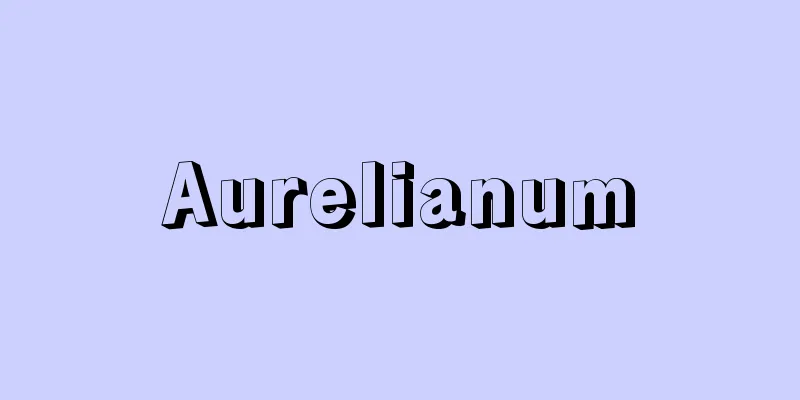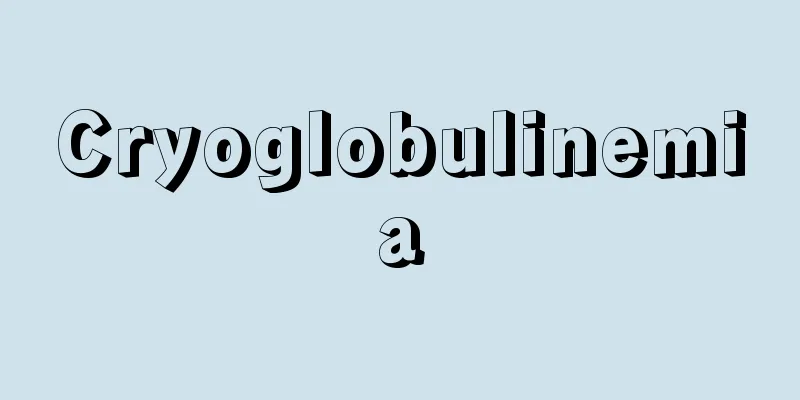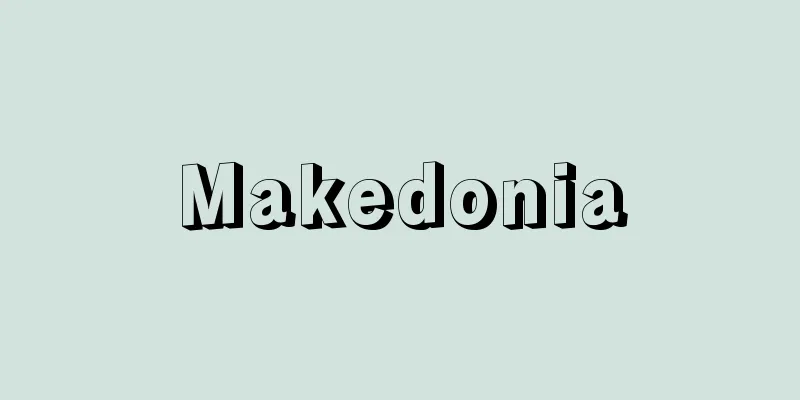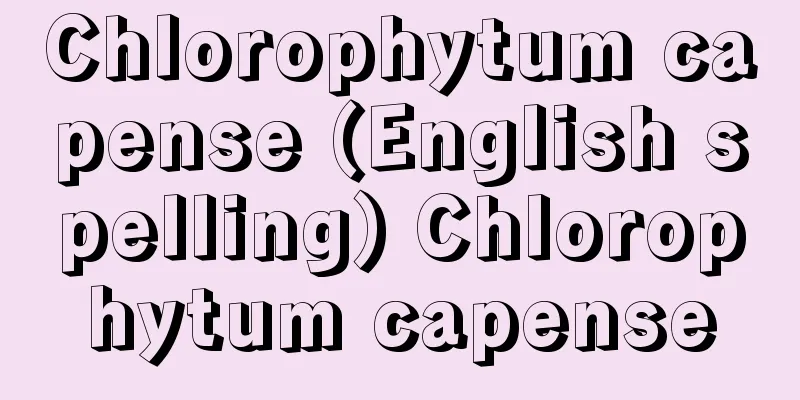Hot Spring Therapy - Onsenryoho

|
A type of hydrotherapy that uses water that contains dissolved natural chemical substances. Hot springs used for balneotherapy are called therapeutic springs. The term therapeutic springs refers to mineral springs that can be used specifically for the treatment of illnesses, and is defined as a spring whose source (the hot spring outlet) is 25°C or higher and contains one of the following: free carbon dioxide, copper ions, total iron ions, aluminum ions, hydrogen ions, total sulfur, or radon. The dissolved chemical substances in hot springs as stipulated in the Hot Springs Act (Act No. 125 of 1948) differ from those in therapeutic springs, so hot springs and therapeutic springs are not necessarily the same thing. Hereinafter, hot springs refer to therapeutic springs. [Kojima Hideo] Japanese hot springsThere are few people in the world who love hot springs as much as Japan, and who love hot springs as much as the Japanese. When comparing Japanese hot springs with hot springs in other countries, there are several characteristics that stand out. First of all, there are many hot springs with temperatures of over 43 degrees Celsius, there is a wide variety of spring quality, and those with strong acidic or alkaline properties are actually used for medical purposes. Another distinctive feature is that the main way to use hot springs is for bathing. In Japan, it is called Touji (hot spring therapy) and has been customarily used as a typical folk remedy since ancient times. It was German physician Baelz, who came to Japan in 1876 (Meiji 9), who reexamined it from the perspective of modern medicine and is considered the father of Japanese balneology. Baelz studied hot springs in Kusatsu, Ikaho, Atami, Hakone, and other places, and introduced them to Europe. Since then, research on hot springs has progressed, and hot spring research facilities and medical facilities have been established in many hot spring areas, and in recent years, hospitals and medical centers specializing in rehabilitation using hot springs have been established. However, in many hot spring areas, touji is carried out without medical examination or guidance, and on the other hand, there are many hot spring areas that are focused solely on pleasure and entertainment. On the other hand, there is a new movement to use hot springs, such as Kusatsu, which involves the whole town thinking about how hot springs should be, and there is certification of specialists (balneotherapy doctors) by the Japanese Society of Balneology, Climatology, and Physical Medicine, as described below. However, compared to other countries, there is no social security system for basic hot spring therapy, and this alone makes Japan lagging behind. [Kojima Hideo] Foreign hot springsWhat makes European hot springs different from Japanese hot springs is that although there are fewer of them and they are cooler, they each contain a lot of minerals and most of them are very concentrated, which is one of the reasons why the springs are primarily for drinking rather than bathing. In the past, European hot springs were used as places for socializing and entertainment, with luxurious baths, but today they are literally therapeutic hot springs. In addition to hospitals, hot springs have drinking fountains, inhalation rooms, hydrotherapy facilities such as exercise baths and douches, mud therapy rooms, hot spring pools, solariums, recreational parks with outdoor theaters and concert halls, sports facilities, libraries, museums, social spaces, and all the other facilities necessary for long-term treatment. Furthermore, Nauheim hot springs in Germany, famous for its hot springs for the heart, is home to the Max Plank research institute known for his research on cardiovascular diseases, and Evian hot springs in France, known for its good for kidney diseases, is home to one of the country's leading kidney research institutes. For example, each hot spring resort has a specialist in the main indications of the hot spring who provides guidance on hot spring treatment, and patients always receive a prescription from the hot spring before undergoing hot spring treatment. The necessary dietary advice is also provided. In this way, hot springs in foreign countries are fundamentally different from Japanese toji (therapeutic bathing), and from hot spring resorts centered around entertainment districts, in that they are centered around hot spring therapy and have social security systems such as health insurance in place, allowing people to receive long-term treatment without worry. [Kojima Hideo] Classification of therapeutic springsMedical springs are classified based on the chemical components they contain to aid in their use. The main categories are listed below: [1] Salt springs - (1) chloride springs, (2) bicarbonate springs, (3) sulfate springs, [2] simple hot springs, [3] Medical springs containing special components - (1) simple cold mineral springs containing special components, (2) simple hot springs containing special components, (3) saline springs containing special components, [4] Medical springs containing two or more special components, [5] Classification of saline springs by spring temperature, [6] Subclassification of saline springs by secondary components. In 1978, the mineral spring analysis method was revised to use a classification table that placed emphasis on dissolved ions, rather than the previous salt table based on contained components, and the names of spring quality were changed accordingly. For example, simple carbonated springs are now called simple carbon dioxide springs, baking soda springs are now called sodium bicarbonate springs, and salt springs are now called sodium chloride springs, but the old names that have been familiar to many are still in use and are often listed together. [Kojima Hideo] The medical benefits of hot springsThe medical benefits of hot springs can be considered as a comprehensive effect of lifestyle responses to various factors, including the specific pharmacological actions of the chemical components of hot springs, physical factors such as heat, buoyancy, and water pressure, the change of scenery caused by the geographical environment of the hot spring area and changes in the bathers' lifestyle, and other factors. [1] Physical effects The greater the difference between the spring temperature and the skin temperature, the greater the thermal stimulation. Bathing at the insensible temperature, where this difference is the smallest (around 36°C, slightly lower when a large amount of carbon dioxide is included), has little impact on the body, allows long bathing, and has a sedative effect. However, Japanese people generally prefer high temperatures, and few people take lukewarm baths. When taking a bath, the water pressure presses on the body, causing blood to flow backwards to the heart, increasing the burden on the heart. Cold water constricts the skin blood vessels, making this effect even greater. Hot water also temporarily constricts the skin blood vessels, causing an initial rise in blood pressure, so it is not good for patients with hypertension or heart disease to rush into cold or hot water. In hot water, the skin blood vessels that have once constricted eventually expand, causing a drop in blood pressure. Taking a long bath can even cause cerebral anemia as soon as you get out of the bath, but pouring water over the head has been used empirically as a preventative measure. This involves pouring water over the head before bathing, which expands the blood vessels in the head in advance, allowing you to deal with rising and falling blood pressure. Water pressure can also be used alone as a douche method or irrigation method, and waterfall baths (cascading baths) are a type of douche method that has been used in Japan since ancient times. The buoyancy of water makes the body weight lighter, so even if muscles are too weak to resist gravity, they can still move their limbs if they move slowly. The heat also relieves muscle contracture and pain, making movement easier, and automatic movement increases blood flow to the muscles, making it even more effective at helping atrophied muscles recover. The combination of a lukewarm bath and exercise is the most effective way to recover from muscle and joint illnesses, and because of the medical effects of the hot spring ingredients on the nerves and musculoskeletal system, it is now widely used in the field of rehabilitation. [2] Chemical effects Most of the chemicals dissolved in hot springs are in the form of ions, which may enter the body through the skin when bathing, or may adhere to the surface of the skin. The amount that penetrates the body is much less than that of general medicines, but they gradually enter the body through the skin all over the body, causing changes in the subcutaneous connective tissue and triggering a systemic defense reaction. Examples of substances that adhere to the skin surface include sodium chloride, which prevents water from evaporating and provides heat retention, sulfur, which softens the skin and dissolves keratoconjunctivitis, and aluminum sulfate, which has an astringent effect on the skin. [3] Other benefits include the climatic, medical and psychological effects of a change of location, freedom from daily work and housework, and a change in diet. In short, balneotherapy does not directly affect the external causes of disease, as in chemotherapy or surgical therapy, but rather acts directly on the patient's body to increase resistance to disease and regulate daily activities, thereby exerting a therapeutic effect. Therefore, a certain amount of time (approximately 2-3 weeks or more) is required, during which time a specific pharmacological effect is expected due to the special action of the ingredients contained in the spa. This whole-body modulation effect is particularly important for its effectiveness. However, after 3-4 weeks, the patient becomes accustomed to the hot spring and the effect gradually decreases, so it is appropriate to repeat the treatment every 3-4 weeks, with a break in between. This coincides with what has been said from experience that a cycle should be at least 10 days to 2 weeks, and at most one month. The effect is thought to last for several months after the end of the treatment, so it is ideal to repeat balneotherapy at intervals of about 1 to 6 months. [Kojima Hideo] Medical Use of Hot SpringsThe main medical uses are bathing and drinking the hot springs. In Japan, bathing is the norm, with drinking the hot springs only occurring in a small number of hot springs, which is the opposite of Europe, as mentioned above. Other uses include gargling, irrigation, and cleansing, and some people inhale hot spring water by spraying it or inhaling the hot spring gas. Hot spring heat, steam, or fumarolic gas are also used for steam baths, carbon dioxide springs are used as soft drinks, and mud from hot springs is used for mud baths and mud compresses. In addition, bathing methods that have been known since ancient times as special bathing techniques, such as time bathing and lukewarm long bathing, are explained in the Touji section. [Kojima Hideo] Bathing precautionsBath once a day for the first few days, gradually increasing the number of times to two or three times a day. Bathing time should be three to ten minutes, depending on the temperature of the hot spring, and can be extended as you become accustomed to the water. People who are prone to hot water blisters should wash or wipe their bodies with fresh water after bathing, but usually people should rest for a certain amount of time without rinsing off the hot spring ingredients, so as not to catch a chill. When bathing in a hot spring, warm your body by pouring hot water over yourself, or pouring hot water over yourself. Avoid bathing immediately before or after a meal, and be especially careful about bathing after drinking alcohol. [Kojima Hideo] Precautions when drinking hot springsFor drinking, fresh hot spring water should be used. The normal amount is about 100-200 ml per serving, but for strong salt springs, acidic springs, aluminum-containing springs, and iron-containing springs, the amount should be reduced or diluted depending on the spring quality and concentration, and the daily amount should be up to 200-1000 ml. Normally, water should be drunk 30 minutes to an hour before a meal, or on an empty stomach, and drinking after dinner or before going to bed should be avoided as much as possible, but iron-containing springs, radioactive springs, and springs containing arsenic or iodine should be drunk after meals, and tea or coffee should not be consumed immediately after drinking iron-containing springs. [Kojima Hideo] Hot spring sicknessAbout three days to a week after starting hot spring therapy, systemic symptoms such as lethargy, loss of appetite, drowsiness or insomnia, headache, dizziness, and fever may appear, and neuralgia, diarrhea or constipation, stone attacks, joint pain, and rashes may appear to have recurred or worsened. This is called hot spring reaction (hot water touch, bath reaction). These symptoms will gradually subside within three to four days, after which the illness will improve. Hot spring reaction has nothing to do with the effectiveness of hot spring therapy, so it is best to keep it as mild as possible. If the symptoms are severe, either refrain from bathing or reduce the number of times you bathe. If the symptoms persist or worsen despite this, there is concern that there may be an acute recurrence of the original illness or the onset of a secondary illness, so a detailed examination by a doctor is necessary. However, care should be taken as drinking the springs can also cause hot spring sickness. Hot springs such as sulfurous springs and radioactive springs are prone to cause hot spring sickness, and illnesses such as rheumatism, neuralgia, liver disease, and gout can also be caused by drinking the springs. [Kojima Hideo] IndicationsThe indications for hot springs are illnesses for which balneotherapy is believed to be effective, including neuralgia, muscle pain, joint pain and stiffness, frozen shoulder, motor paralysis, bruises, sprains, chronic digestive diseases, hemorrhoids, intolerance to cold, and convalescence from illness, as well as fatigue recovery and health promotion. As mentioned above, the medical benefits of hot springs depend on the biological response to the combined effects of physical factors and chemical components, the topography and climate of the hot spring area, and changes in the user's living conditions, and it is difficult to determine the effectiveness of each hot spring based on its components alone, but the indications for therapeutic hot springs mentioned here are generally intended as a guideline. Therefore, there may be other traditional indications, but it is advisable to consult the opinion of a doctor with specialized knowledge (such as a balneotherapy doctor) regarding these. The same applies to the contraindications described below. In addition, chronic digestive diseases that are indications for this drug include gastritis, as well as hyperacidity, hypoacidity, gastrointestinal hypersensitivity, and after-effects of gallbladder surgery. [Kojima Hideo] ContraindicationsDiseases that can worsen when bathing in a hot spring are called contraindications, and when choosing a hot spring, it is necessary to pay attention not only to the indications but also to the contraindications. General contraindications include all acute diseases (especially those with fever), as well as active tuberculosis, malignant tumors, severe heart disease, respiratory failure, renal failure, bleeding diseases, severe anemia, and other diseases that are generally progressing, as well as pregnancy (especially in the early and final stages). As a general rule, people with severe arteriosclerosis and high blood pressure are also contraindicated from bathing in temperatures above 42°C. Furthermore, even if hot springs are generally said to be good for rheumatism, they are contraindicated for children with rheumatic fever, and even if they are said to be good for neuralgia, it is not appropriate to use hot springs on your own judgment without investigating the cause and condition of the condition. As with drinking hot spring therapy, it is advisable to consult a balneotherapy doctor and get a prescription. [Kojima Hideo] Balneotherapy DoctorA balneotherapy specialist will diagnose your condition and then decide on the appropriate hot spring quality and method of use. The Japanese Society of Balneotherapy, Climatology, and Physical Medicine established the Balneotherapy Certification Doctor System in 1976, and certifies balneotherapy doctors after undergoing rigorous qualification screening. [Kojima Hideo] "Guidelines for Hot Spring Therapy, by Oshima Yoshio and Yano Ryoichi, revised 3rd edition (1991, Japan Spa Association) " ▽ "Bathing and Hot Spring Therapy Manual, edited and published by the Japanese Society of Balneology, Climatology and Physical Medicine (1999)" ▽ "Hot Spring Therapy - The Amazing Health Power, edited by Noguchi Fuyuto (2001, Modern Travel Research Institute)" ▽ "Hot Spring Therapy - An Approach to Healing, by Otsuka Yoshinori, 2nd edition (2001, Nanzando)" ▽ "Hot Spring Therapy Handbook, edited and published by the Private Sector Development Organization, 4th edition (2003, ViewPro)" ▽ "The Medicine of Hot Springs, by Iijima Yuichi (Kodansha Gendai Shinsho)" [Reference items] | | | | | | | | | |Hot spring | | | |Source: Shogakukan Encyclopedia Nipponica About Encyclopedia Nipponica Information | Legend |
|
天然の化学物質が溶け込んでいる水を利用した水治療法の一つ。温泉療法に利用する温泉を療養泉という。療養泉とは、鉱泉のうち、とくに病気の治療目的に供しうるものをいい、源泉(温泉湧出(ゆうしゅつ)口)での温度が25℃以上で、遊離二酸化炭素、銅イオン、総鉄イオン、アルミニウムイオン、水素イオン、総硫黄、ラドンのうち、いずれか一つは含有するものと定義されている。溶存する化学物質は、温泉法(昭和23年法律125号)に規定されている温泉の溶存物質と療養泉の場合は異なるところがあり、いわゆる温泉と療養泉とはかならずしも一致しないわけである。以下、ここでいう温泉は療養泉をさす。 [小嶋碩夫] 日本の温泉日本ほど温泉が多く、また日本人ほど温泉好きな国民は世界でも珍しい。日本の温泉を外国の温泉に比べると、いくつかの特徴があげられる。まず43℃以上の高温泉が多いこと、泉質が豊富で酸性やアルカリ性の強いものが実際に医療的に使われているほか、利用法として入浴が主になっていることなども、特色の一つである。 日本では湯治(とうじ)と称し、代表的な民間療法として古くから慣習的に利用してきたが、これを近代医学の目で見直したのは、1876年(明治9)来日したドイツの内科学者ベルツで、日本の温泉医学の祖とされている。ベルツは草津温泉をはじめ、伊香保(いかほ)、熱海(あたみ)、箱根などの諸温泉について研究し、広くヨーロッパに紹介した。それ以来温泉の研究が進展し、多くの温泉地に温泉研究施設や療養施設ができ、近年は温泉利用のリハビリテーション専門の病院や療養所が設けられている。しかし多くの温泉地では、医師の診察、指導もなく湯治が行われており、一方では歓楽や遊興の色彩が濃く、それのみといった温泉地も多いのが現状である。これに対して草津温泉のように、温泉地のあり方を含めた町ぐるみで考える新しい温泉利用の動きもあり、後述のような日本温泉気候物理医学会による専門医(温泉療法医)の認定なども行われているが、諸外国に比べて基本的な温泉療養に対する社会保障制度がなく、これだけでも大きく立ち後れている。 [小嶋碩夫] 外国の温泉ヨーロッパの温泉が日本の温泉と異なる点は、数が少ないうえに温度も低いが、それぞれ含有成分の量が多く、そのほとんどが濃厚であることで、これが入浴よりも飲泉を主とする理由の一つでもある。 昔はヨーロッパでも豪華な浴場を設けて華やかな社交・娯楽の場として利用した時代もあったが、今日では文字どおりの療養泉といった様相を呈している。すなわち、病院はもとより、飲泉所や吸入室、運動浴や圧注などの水治療法施設、鉱泥治療室、温泉プール、日光浴室のほか、野外劇場やコンサート・ホールなどのある保養公園をはじめ、スポーツ施設や図書館、博物館、社交場など長期療養に必要なあらゆる施設が整っている。さらに心臓の湯として有名なドイツのナウハイム温泉には循環器病の研究で知られるマックス・プランクMax Plankの研究所があり、腎臓(じんぞう)病によいといわれるフランスのエビアン温泉には国内屈指の腎臓研究所があるなど、各温泉地にはその温泉のおもな適応症の専門医がいて温泉療養の指導を行い、かならずそこで処方をもらって温泉治療をする仕組みになっており、必要な食事療法の指導も行っている。 このように、外国の温泉は、温泉療養が中心であり、健康保険などの社会保障制度が導入されているために長期療養も安心して受けられる点で、日本の湯治はもとより、歓楽街を中心とした温泉地とは根本的に違っている。 [小嶋碩夫] 療養泉の泉質分類療養泉は、その利用に資する目的で、含有する化学成分に基づいて分類されている。主要項目を次に列挙しておく。〔1〕塩類泉―(1)塩化物泉、(2)炭酸水素塩泉、(3)硫酸塩泉、〔2〕単純温泉、〔3〕特殊成分を含む療養泉―(1)特殊成分を含む単純冷鉱泉、(2)特殊成分を含む単純温泉、(3)特殊成分を含む塩類泉、〔4〕特殊成分を2種以上含む療養泉、〔5〕泉温による塩類泉の分類、〔6〕副成分による塩類泉の細分類。 なお、1978年(昭和53)に鉱泉分析法が改定されて、従来の含有成分によって構成された塩類表中心から、溶有イオンに重点を置いた分類表を用いるようになり、泉質名もそれに従って改称された。たとえば、単純炭酸泉が単純二酸化炭素泉、重曹泉がナトリウム―炭酸水素塩泉、食塩泉がナトリウム―塩化物泉などとよばれるようになったが、従来親しまれてきた旧泉質名もまだ使われており、併記されている場合が多い。 [小嶋碩夫] 温泉の医治的効用温泉の化学成分による特異的な薬理作用をはじめ、温熱、浮力、水圧などの物理的因子、温泉地の地理的環境や浴客の生活様式の変化などによる転地効果、その他いろいろな因子に対する生活反応の総合的効果として温泉の医治的効用が考えられる。 〔1〕物理的作用 温度刺激は泉温と皮膚温との差が大きいほど大である。この差がもっとも少ない不感温度(36℃前後で、炭酸ガスを多量に含有するとやや低くなる)で入浴すると、身体に与える影響が少なく長時間の入浴が可能であり、鎮静的な効果がある。しかし日本人は一般に高温を好み、微温浴の利用者は少ない。 入浴すると水圧で身体が圧迫され、血液が心臓へ逆流するようになり、心臓の負担が増加する。冷水では皮膚血管が収縮し、この影響がさらに大きくなる。熱い湯でも一過性に皮膚血管が収縮して血圧の初期上昇がおこるので、高血圧症や心臓病の患者が急いで冷水や熱い湯に入るのはよくない。熱い湯では、いったん収縮した皮膚血管がやがて拡張してくるので、血圧が低下する。長湯していて湯からあがったとたんに脳貧血をおこすことさえあるが、この予防として経験的にかぶり湯が行われてきた。これは入浴前に頭部へ湯をかけ、あらかじめ頭部の血管を拡張させておくわけで、血圧の上昇と低下に対処できる。なお、水圧は単独にも圧注法や灌水(かんすい)法として利用され、滝の湯(打たせ湯)などは日本古来の圧注法の一種である。 水の浮力は体重を軽くさせるので、普通、重力に対抗するだけの力がないほど減弱した筋力でも、ゆっくり動かせば四肢の運動が可能になる。また温熱作用によって筋肉の拘縮(こうしゅく)と痛みも緩解(かんかい)するので、運動がさらに容易になるとともに、自動運動によって筋肉の血流が増加し、萎縮(いしゅく)した筋肉の回復にとっては一段と効果が大きくなる。こうした微温浴と運動の併用は、筋肉や関節の病気の回復にもっとも有効な手段で、これに温泉成分の神経や運動器に及ぼす医学的効果も加わるため、現在ではリハビリテーションの分野で広く利用されている。 〔2〕化学的作用 温泉中には化学物質が大部分はイオンの形で溶け込み、入浴によってこれが皮膚を通して体内に入る場合と、皮膚表面に付着する場合がある。体内に浸透する量は一般の治療薬に比べてはるかに少ないが、全身の皮膚から徐々に入り皮下の結合織に変化をおこして全身的な防衛反応を引き起こす。皮膚表面に付着する例としては、塩化ナトリウムは水分の蒸発を妨げて保温作用を現し、硫黄(いおう)は皮膚の軟化作用や角質溶解作用を示し、また硫酸アルミニウムには皮膚の収斂(しゅうれん)作用がある。 〔3〕その他 転地による気候医学的および精神的な影響をはじめ、日常勤務や家事からの解放、食事の変化なども有利に働いている。 要するに、温泉療法とは、化学療法や手術療法などのように病気の外因に対して直接働きかけるものではなく、患者の身体に直接働きかけて病気に対する抵抗力を高め、生活活動を整調化することによって治療効果を現すものである。したがって、ある程度の日時(約2~3週間以上)が必要であり、この間に含有成分の特殊作用による特有の薬理学的効果が期待される。この全身変調作用が効用にとってはとくに重要である。しかし、3~4週間経過すると温泉に対する慣れが出てきて効果がすこしずつ低下するので、3~4週間を1回りとして休みを挟んで繰り返すのが適当である。これは、経験的に1回りは短くて10日から2週間、やや長くて1か月といわれてきたことと合致する。この効果は療法終了後も数か月続くとみられるので、温泉療法は1か月から6か月ほどの間隔を置いて繰り返すようにするのが理想的である。 [小嶋碩夫] 温泉の医治的利用おもな医治的利用法は入浴と飲泉である。日本では入浴が主体で、飲泉はごく一部の温泉で行われているにすぎず、前述のようにヨーロッパとは逆になっている。このほか、うがい、灌注(かんちゅう)、洗浄などの利用法もあり、温泉を噴霧吸入したり、温泉のガスを吸入するものもある。また温泉熱や蒸気あるいは噴気を利用しての蒸し湯も行われ、清涼飲料としての二酸化炭素泉の利用、温泉の泥を利用する鉱泥浴や鉱泥湿布も行われている。 なお、時間湯や微温長時間湯など、古くから特殊な入浴法として知られるものについては、湯治の項目で解説する。 [小嶋碩夫] 入浴上の注意最初の数日は1日1回くらい入浴し、徐々に1日2回ないし3回まで増やしていく。入浴時間は温泉の温度にもよるが、3分ないし10分間とし、慣れるにしたがって延長してよい。湯ただれをおこしやすい人は浴後に真水で身体を洗うかふき取るが、普通は温泉成分を洗い流さずに、一定時間、湯冷めしないように休息する。熱い温泉に入るときは、かけ湯をして身体を温めるか、かぶり湯をする。食事の直前や直後の入浴は避けるようにするが、とくに飲酒しての入浴は注意する。 [小嶋碩夫] 飲泉上の注意飲泉は温泉湧出口の新鮮なものを用いる。1回量は普通100~200ミリリットル程度であるが、強塩泉や酸性泉、含アルミニウム泉および含鉄泉は、その泉質と濃度によって減量または希釈して飲用し、その1日量は200~1000ミリリットルまでとする。普通は食前30分から1時間、または空腹時に飲用し、夕食後から就寝前の飲用はなるべく避けるが、含鉄泉、放射能泉およびヒ素またはヨウ素を含有する温泉は食後に飲用し、含鉄泉飲用の直後には茶やコーヒーなどを飲まない。 [小嶋碩夫] 湯あたり温泉療法開始後3日ないし1週間前後に、だるさ、食欲減退、眠気または不眠、頭痛、めまい、発熱などの全身症状がみられ、神経痛、下痢または便秘、結石発作、関節痛、発疹(はっしん)などが再燃悪化したようにみえることがある。これを湯あたり(湯さわり、浴湯反応)という。これらの症状は3~4日でしだいに軽快消退し、その後は病気がよくなる。湯あたりは温泉療法の効果とは関係なく、なるべく軽くすませるようにする。症状が激しければ、入湯を休むか、回数を減らす。それでもなお症状がとれない場合や増悪するときは、本来の病気の急性再燃か余病併発の懸念があるので、医師の精密検査が必要になる。 なお、飲泉療法でも湯あたりがおこるので注意する。また、泉質としては硫黄泉や放射能泉などでおこりやすく、疾患としてはリウマチ、神経痛、肝疾患、痛風などにおこりやすい。 [小嶋碩夫] 適応症温泉療法が効果を現すとみられる疾患が温泉の適応症で、神経痛、筋肉痛、関節痛やこわばり、五十肩、運動麻痺(まひ)、打ち身、くじき、慢性消化器病、痔疾(じしつ)、冷え症、病後回復期のほか、疲労回復や健康増進が一般的適応症である。既述のように温泉の医治的効用は、物理的因子や化学的成分、温泉地の地勢や気候、利用者の生活状態の変化などの総合作用に対する生体反応によるものであり、温泉の成分だけで各温泉の効用を確定することは困難であるが、ここに述べた療養泉の適応症はおおむねその基準を意味するものである。したがって、このほかにも伝統的適応症が考えられるが、これについては専門的知識を有する医師(温泉療法医など)の意見を参考にすることが望ましい。これらは次に述べる禁忌症についても同様である。 なお、適応症にある慢性消化器病は、胃炎をはじめ、胃酸過多症、胃酸減少症、胃腸過敏症、胆嚢(たんのう)手術後の後遺症なども含まれている。 [小嶋碩夫] 禁忌症温泉を利用したために悪化する疾患を禁忌症といい、温泉を選ぶときは、適応症ばかりでなく禁忌症にも注意する必要がある。一般的禁忌症としては、すべての急性疾患(とくに熱のある場合)をはじめ、活動性の結核、悪性腫瘍(しゅよう)、重症の心臓疾患、呼吸不全、腎不全、出血性疾患、高度の貧血、そのほか一般に病勢が進行中の疾患、あるいは妊娠中(とくに初期と末期)があげられる。高度の動脈硬化症や高血圧症も原則として42℃以上の高温浴は禁忌である。 なお、一般にリウマチによいとはいっても、子供のリウマチ熱は禁忌であり、また神経痛によいといっても、その原因や病状なども調べずに自己判断で温泉を利用するのは適当でない。飲泉療法を行う場合と同様に、温泉療法医に相談し、処方してもらうのが望ましい。 [小嶋碩夫] 温泉療法医温泉療法の専門医で、病状を診断したうえで適当な泉質の温泉と利用法を決めてくれる。日本温泉気候物理医学会では、1976年(昭和51)に温泉療法認定医制度を発足させ、厳重な資格審査のうえで温泉療法医を認定している。 [小嶋碩夫] 『大島良雄・矢野良一著『温泉療養の指針』改訂第3版(1991・日本温泉協会)』▽『日本温泉気候物理医学会編・刊『入浴・温泉療養マニュアル』(1999)』▽『野口冬人編著『温泉療法――驚異の健康パワー』(2001・現代旅行研究所)』▽『大塚吉則著『温泉療法――癒しへのアプローチ』第2版(2001・南山堂)』▽『民間活力開発機構編・刊『温泉療養の手帖』第4版(2003・ビュープロ発売)』▽『飯島裕一著『温泉の医学』(講談社現代新書)』 [参照項目] | | | | | | | | | | | | | |出典 小学館 日本大百科全書(ニッポニカ)日本大百科全書(ニッポニカ)について 情報 | 凡例 |
>>: Hot spring name - Onsenmei (English)
Recommend
L'Aquila (English spelling)
L'Aquila is the capital of the Abruzzo region ...
Perigee - Perigee
The moon and artificial satellites revolve around...
Ashikita [town] - Ashikita
A town in Ashikita District, southwest of Kumamoto...
Ortolani's test
...However, if the dislocation is left untreated,...
Ergosterol
…Cholesterol is almost nonexistent in plants, and...
Basket Maker
…Phase I is generally divided into Phase II and I...
Foreign Languages - Gaikokugo
English: (noun) a foreign language (as opposed to ...
London Money Market
A global financial market in London. The so-called...
Honcho Tsugan - Japanese translation
A history book compiled by the shogunate in the e...
Zither - Chitaa (English spelling)
In a broad sense, it is a classification name for...
flame analysis
...When a substance is placed in a flame, the ato...
Dampier, William
Born: 1652. East Coker, Somerset. [Died] March 171...
Cenaculum
... The ground floor of the insula was either ren...
American School
A short story by Kojima Nobuo. Published in 1954, ...
Toyokawa [city] - Toyokawa
A city in the southeastern part of Aichi Prefectur...









